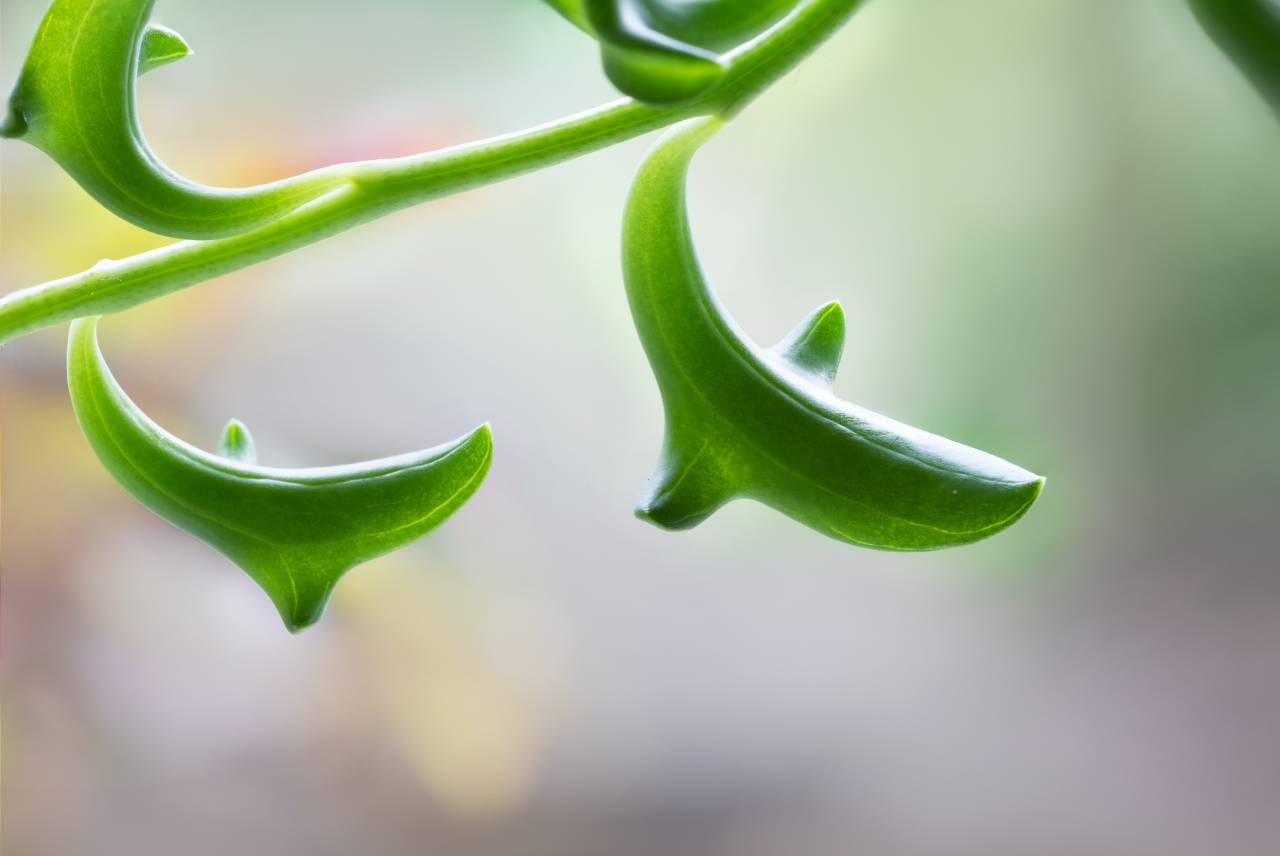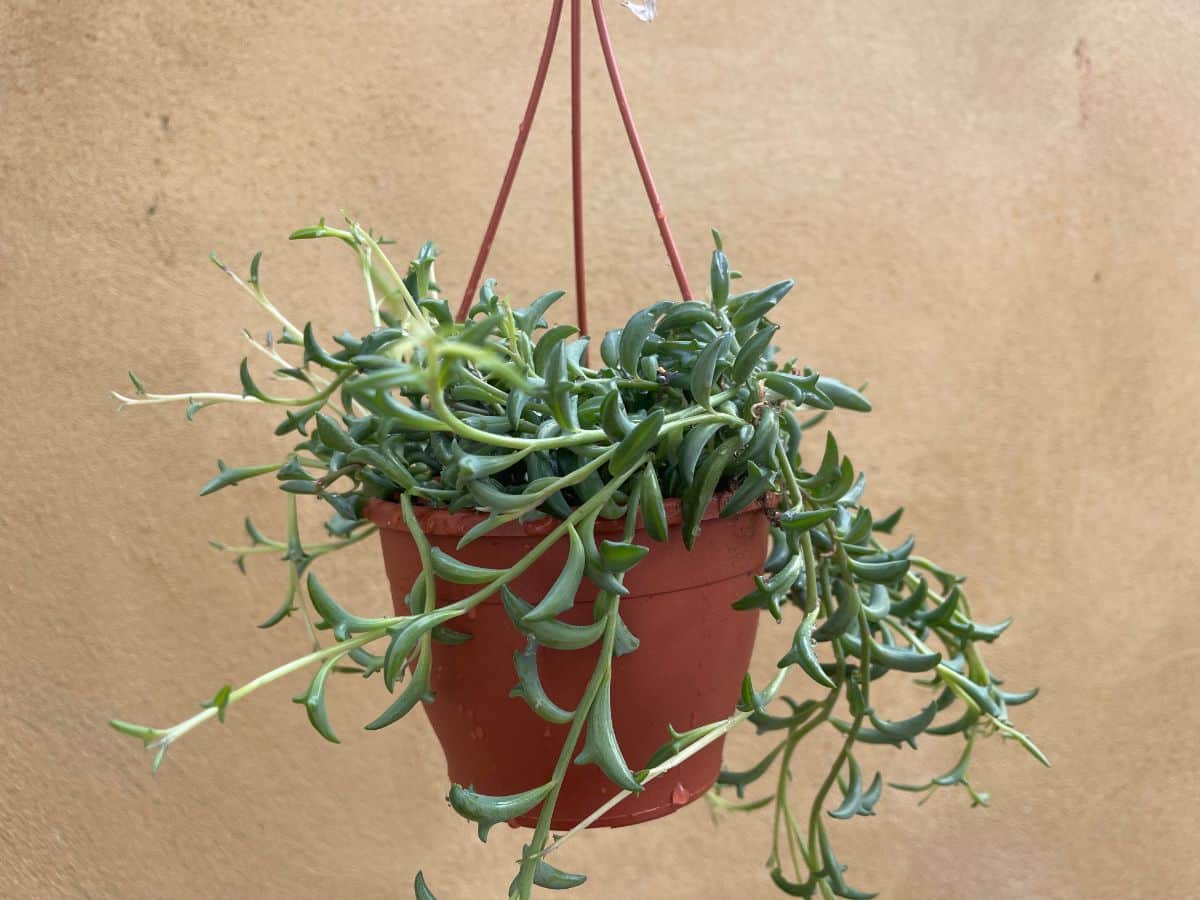
The string of dolphins is a rare species of succulents sought after by many succulent lovers, so knowing how to propagate them is all the more important. This article is the ultimate holy grail of propagation and care for a string of dolphins succulents. Take notes as you read through this post, and save it somewhere safe to ensure your plant thrives. Enjoy!
Jump to:
Description
| Name: | Senecio peregrinus |
| Soil: | Arid, well-draining soil |
| Blooming: | May and June |
| Light: | At least six hours of sunlight a day |
| Water: | Waterevery 7 to 10 days |
| Propagation: | Stem cuttings |
Senecio peregrinus AKA ‘string of dolphins’ is a rare and delicate succulent that has dolphin-shaped leaves that spill delicately over the plant pot on their long hanging stem. It gives off calm ocean vibes and a beachy feel, which is what makes it all the more popular worldwide.
You can expect this gorgeous plant to bloom delicate whitish-pink flowers in the late spring that give off a soft cinnamon scent. Its flowers form in clusters and hang from the main plant. The more mature and healthy your plant is, the longer its trail will be and the more powerful its appearance is.
Propagation Guide
You can easily propagate a string of dolphins succulents in water and in soil. Propagating a succulent plant in water is unusual for these plants as they are usually not tolerant of too much water. Follow the steps below and try it for yourself!
Stem Cuttings
The easiest way to propagate a string of dolphins is using healthy stem cuttings. You will need to choose whether you want to propagate your plant in water or in the soil before moving any further. Here is a step-by-step guide for both methods.
Propagating in Water
1. Get your Equipment Ready
You will need a clean knife, a jar, and clean water to propagate a string of dolphins in the water. Collect all of the equipment and set up your station.
2. Cut the Stem using a Clean Sharp Knife
Cut a five-inch or longer stem from the mother plant. Do not attempt to propagate the succulent with a shorter stem as it may not work. Remove all of the bottom leaves from the stem to make sure that the leaves do not rot in the water.
3. Place in Water
Put the stem in water and leave it for a couple of weeks. You should notice new roots growing from the bottom of the stem; this is an indicator that your plant is ready to be planted into well-drained soil.
Propagating in Soil
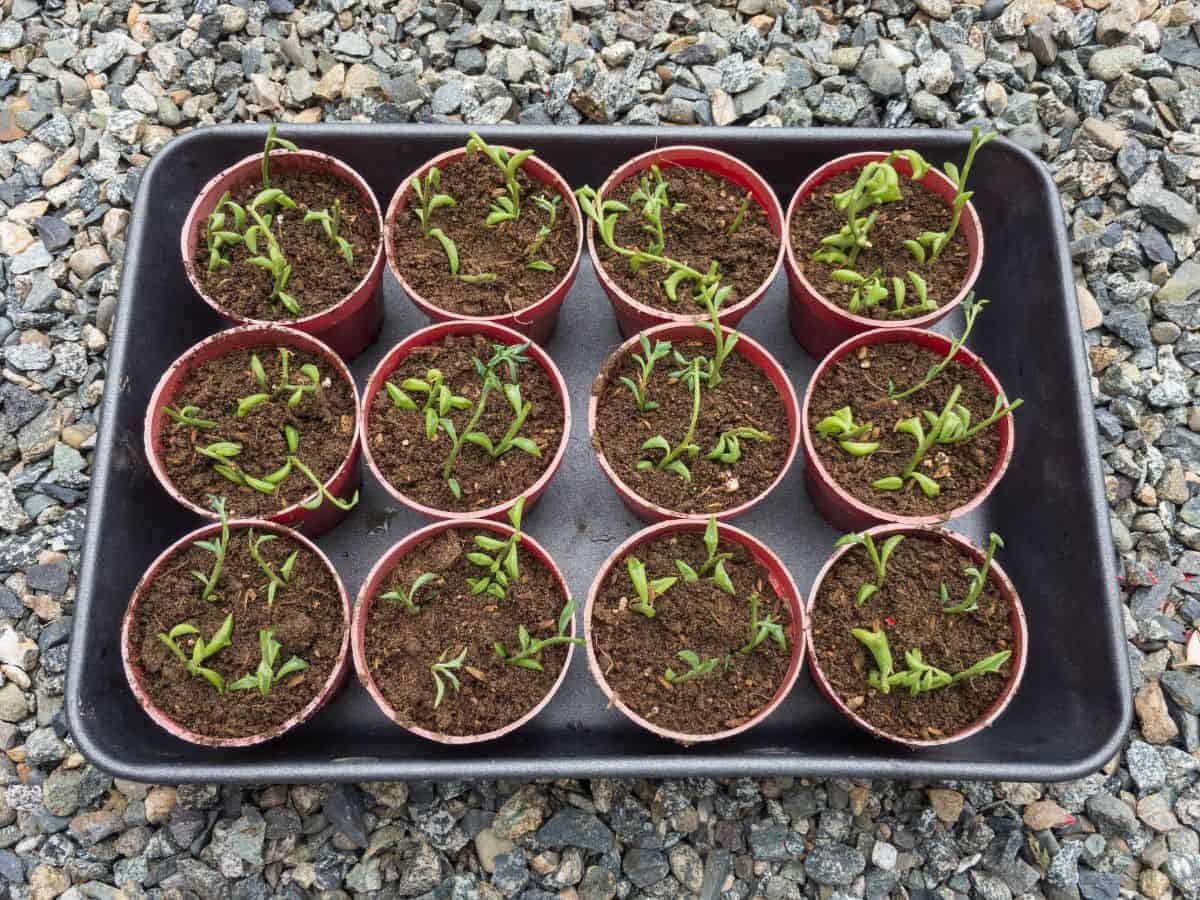
Buy it from:
1.Gather your Equipment
Get your equipment together before starting. You will need paper towels, a sharp knife, cactus or succulent potting soil, and a small pot.
No products found.
2. Cut the Stem
Cut at least five inches of healthy stem from the main plant. The stem should be firm with the ability to hold its shape.
3. Leave to Callus over for a Few Days
Leave the stem to dry out or ‘callus’ for a few days. Once the cut end of the stem is completely dry you can move onto the next step.
4. Dip in Rooting Hormone
Dip the cut end of the stem in the rooting hormone.
5. Place in Soil
Place the cut end of the stem in soil with good drainage. Remember to remove the bottom leaves from the stem to prevent them from rotting. Put the plant in a sunny part of the room, but not in direct sunlight and water when the soil is dry to touch.
Seeds
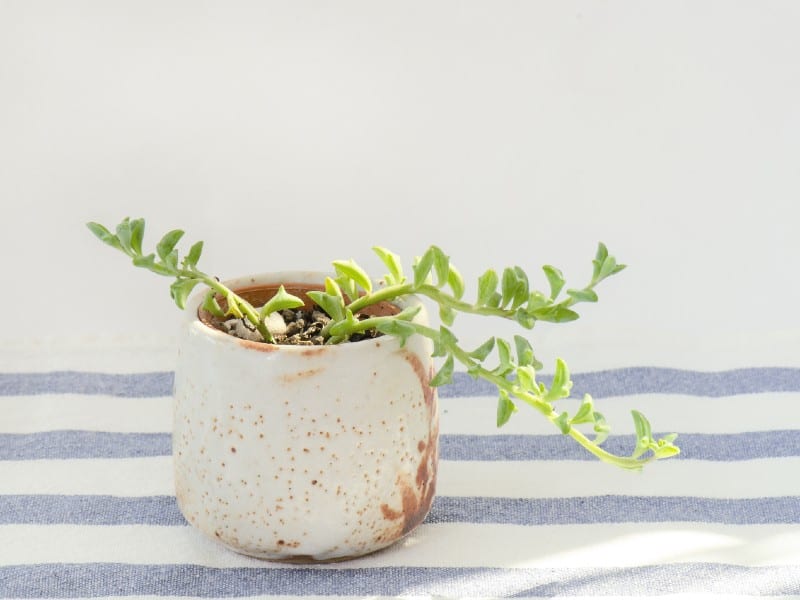
Growing a string of dolphins from seeds is quite straightforward too. Purchase seeds from a well-known retailer or seed distributor to get the best chances of success. Here is a step-by-step guide for growing these succulents from seeds:
1.Soak the Seeds
Soaking the seeds in warm water, followed by cold water, helps them germinate.
2. Poke Holes into the Soil
Poke holes in the soil about half an inch deep, and ensure that each hole has a distance of an inch or so between them. Place one seed into each hole.
3. Cover
Cover the seeds with a light sprinkle of cactus or succulent potting soil.
4. Water
Water the soil whenever it has dried out completely. This usually takes about three to four days after watering.
Cultivars and Hybrids
The string of dolphins succulents is a hybrid of the string of pearls and the candle plant. It closely resembles the string of pearls plant, far more than it does the candle plant.
General Care Guide
In order to be able to propagate your string of dolphins plants, you will need to ensure it is healthy and thriving. Although caring for a string of dolphins is relatively easy, there are a few rules and guidelines that growers must follow.
Succulents are usually hard plants to kill due to them being so resistant and hardy plants. Over fussing and unnecessary care is one of the worst things you can do to your plant, which is why understanding its needs is crucial. Take a look at the following section to learn some helpful tips and tricks about caring for a string of dolphin plants.
Light
Succulents typically thrive in direct sunlight, but the string of dolphins is a little bit more delicate. Direct sunlight for long periods of time will damage the plant’s delicate leaves and result in them becoming sunburnt. Unfortunately, succulents can not repair the damage caused by sunburn, so you will need to prune away damaged areas of the plant if this occurs.
Of course, you want to place your succulent in an area where it will look the most aesthetic and striking, but you must also consider how much sunlight it gets. The string of dolphins plants needs at least six hours of indirect sunlight to grow to their full potential.
Advice for Growing your Plant Outside
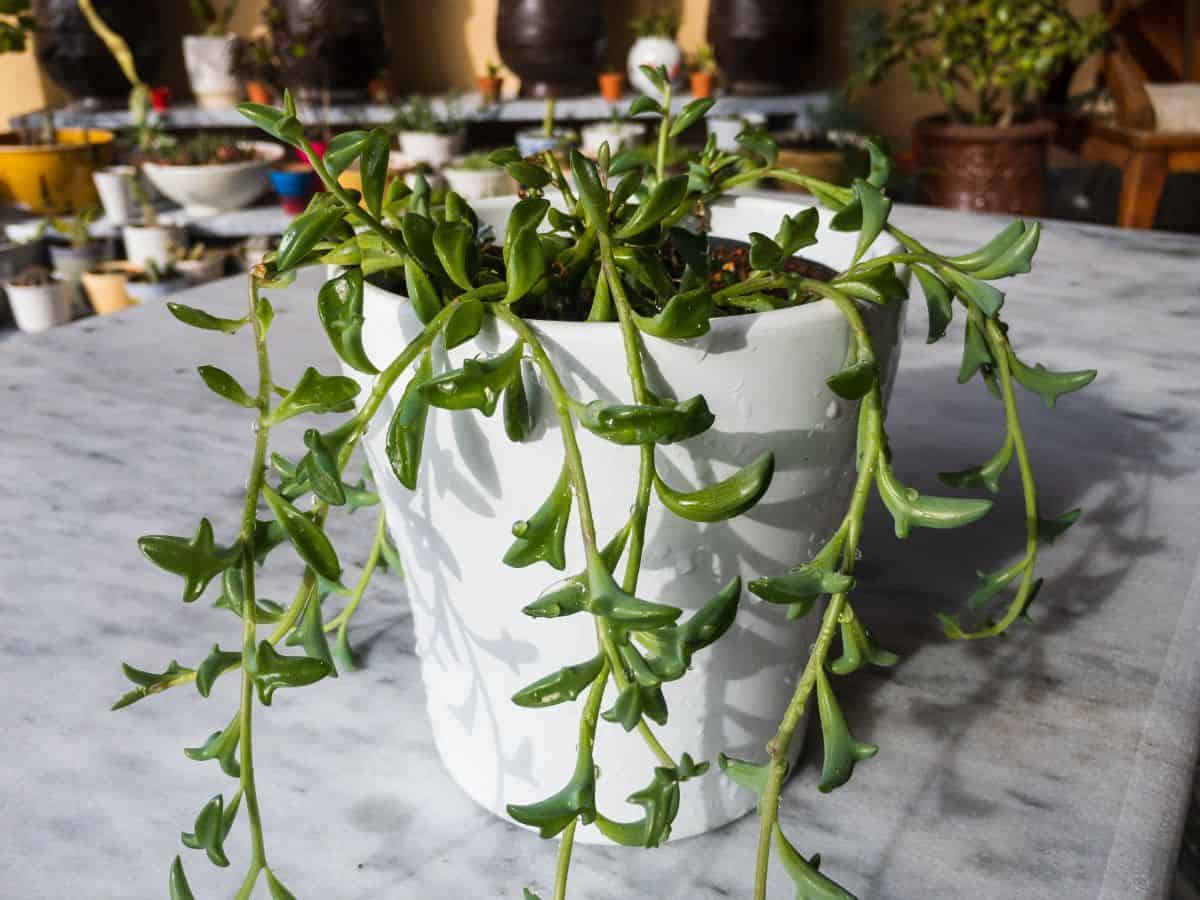
The string of dolphins looks stunning in hanging baskets outside your home, but you need to think about where the basket is located and how much light the succulent will get in that location. Fortunately, succulents grown in hanging baskets can be moved around, so if you can try out a few different locations and see what works best.
Advice for Growing your Plant Inside
Many people growing a string of dolphins succulents indoors place them on bookshelves and in other high places in the house so that they can enjoy the beauty of their long trailing stems. Always remember to put the plant near a sunny window that lets in between four to six hours of sunlight every day.
Water
The string of dolphins succulents has standard water requirements typically found for succulent plants. Their small leaves can retain water for a long time, making them hardy, drought-tolerant plants.
The plant is dormant during the fall and winter months, so it may not need to be watered for weeks or even months on end. The best way to tell if your succulent needs water is by touching its soul. Poke the soil and rub a bit between your fingers to determine whether the soil is dry, wet, or damp.
Do not water the plant if the soil is wet or damp as this can cause root rot. It is best practice to use the ‘soak and dry’ method of watering for a string of dolphins succulents. Water your plant generously only when the soil has dried out completely, and check the soil’s moisture content daily to ensure your plant care tasks are done on time.
Note: Outdoor succulents that are exposed to lots of rainwater could develop associated diseases and problems, which is why it is important to bring your plant indoors during heavy rain.
Temperature
Surprisingly, the string of dolphins succulents has quite a wide range of ideal growing temperatures. During the cooler months, the plant can grow quite happily in temperatures that are as low as 40 degrees Fahrenheit, whereas, during the summer, the string of dolphin succulents can withstand temperatures as high as 80 degrees Fahrenheit.
These temperature ranges are lower than are usually associated with succulents, but that doesn’t mean that they are cold hardy plants by any means. The succulent leaves can freeze and blister, causing permanent damages and scarring to the plant tissue, not to mention being potentially fatal to the plant.
Humidity is also a silent succulent killer. Humid air is rich in moisture and can cause the plant to wilt and rot over a short period of time.
If you live in an area with unpredictable weather or somewhere where frost or humidity is a common occurrence, then you should keep your plant indoors for protection. Alternatively, you can move your plants indoors when you are expecting unusual weather.
Soil
Make sure that you only use cactus or succulent potting soil for your string of dolphins plants. Succulents are very particular about their soil, and not all potting soils fit the criteria.
The soil’s pH levels should be between 6.6 to 7.5, which doesn’t leave a lot of room for error. Experienced succulent growers may choose to mix their own soil together with sand to create a unique potting soil for their plants. If you choose to do this, you need to make sure that the soil you use is not pre-fertilized as too much fertilizer is toxic to succulents.
If you want to give your succulent a head start during spring, you can add a small amount of fertilizer to the soil to help it bloom. This should only be done once or twice every year, and only do so if you are feeling confident and up for the task.
Using the wrong potting soil can be fatal for your plant. Dence soil will suffocate your plant as it holds water for far longer than sandy soil. Dence soil can also interfere with your plant’s ability to grow a strong and sturdy root system.
When in doubt, replant your succulent. If you can’t remember what soil you potted your succulent in, replant it in porous succulents potting soil to avoid damaging the plant.
Common Pests and Problems

Scale, spider mites, aphids, and mealybugs are common pests, but treating the infestation is easy. All you need to do is to remove the pests and treat the plant with an organic or homemade pesticide and wait.
If you do not treat pest infestations in time, the pests will suck the sap out of your healthy plant and cause irreversible damage. Always inspect your plant for signs of pests and stop them in their tracks immediately.
Root rot is the most common disease found amongst a string of dolphin succulents. Root rot is caused by overwatering your plant or planting it in soil that is very dense.
Root rot is a silent killer and often goes unnoticed until it is too late. Wilting stems and leaves, discoloration, soggy leaves, and an overall ‘sad’ looking plant are all telltale signs of root rot.
If you suspect that your plant is suffering from root rot, you must remove it from the soil and inspect its roots. If you notice that your plant has black or brown roots, you must remove the damaged roots immediately and replant the plant in dry, porous potting soil.
All of the damaged areas of the plant should be removed with a sharp, sterile knife. Do not leave any damaged leaves or roots on the plant.
If the majority of the plant is damaged, look for healthy leaves or roots for propagation. Discard the damaged areas of the plant and propagate the healthy leaves and stems, and start again.
The string of dolphins isn’t prone to many diseases. To avoid spreading diseases throughout the plant, make sure that you water it at the base and not overhead.
Do you feel confident in your string of dolphins propagating and growing skills? Let us know about your experiences caring for this unique succulent and share tips and tricks in the comments section below!
Sources:https://extension.umn.edu/houseplants/cacti-and-succulents


